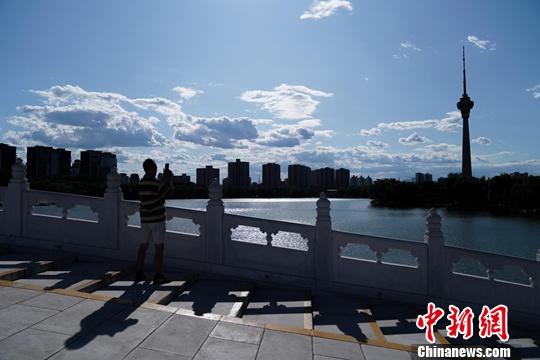Chinanews.com, March 2nd, on the 2nd, the Ministry of Ecology and Environment released the 2020 national ecological environment quality profile on the official WeChat public account.
The "Profile" shows that in 2020, the quality of the national ecological environment will continue to improve.
The average number of good days in 337 prefecture-level and above cities across the country was 87.0%, a year-on-year increase of 5.0%.
Ambient air quality in 202 cities reached the standard, accounting for 59.9% of all cities at prefecture-level and above, an increase of 45 compared to the same period last year.
Data map: Beijing Yuyuantan Park, a tourist photographed the beautiful blue sky and white clouds.
Photo by China News Agency reporter Zhang Xinglong
The "Profile" pointed out that in 2020, the quality of the national ecological environment will continue to improve, and the total emissions of major pollutants and carbon dioxide emissions per unit of GDP will further decline.
The 9 binding indicators of the ecological environment determined in the "13th Five-Year Plan" were successfully over-fulfilled.
In terms of atmosphere, the average number of good days in 337 prefecture-level and above cities across the country was 87.0%, an increase of 5.0% year-on-year.
Ambient air quality in 202 cities reached the standard, accounting for 59.9% of all cities at prefecture-level and above, an increase of 45 compared to the same period last year.
The average annual concentration of PM2.5 was 33 μg/m3, a year-on-year decrease of 8.3%; the average annual concentration of PM10 was 56 μg/m3, a year-on-year decrease of 11.1%.
According to the evaluation of the comprehensive environmental air quality index, among the 168 key cities, the 20 cities with relatively poor ambient air quality (from the bottom to the bottom 20) are Anyang, Shijiazhuang, Taiyuan, Tangshan, Handan, Linfen, Zibo, Xingtai, Hebi, Jiaozuo, Jinan, Zaozhuang, Xianyang, Yuncheng, Weinan, Xinxiang, Baoding, Yangquan, Liaocheng, Binzhou and Jincheng (Binzhou and Jincheng are ranked 20th from the bottom). The ambient air quality is relatively good 20 The cities (from 1st to 20th) are Haikou, Lhasa, Zhoushan, Xiamen, Huangshan, Shenzhen, Lishui, Fuzhou, Huizhou, Guiyang, Zhuhai, Ya'an, Taizhou, Zhongshan, Zhaoqing, Kunming, Nanning, Suining, Zhangjiakou and Dongguan City.
The average percentage of good days in Beijing-Tianjin-Hebei and surrounding areas "2+26" cities was 63.5%, an increase of 10.4 percentage points year-on-year; the average annual PM2.5 concentration was 51 micrograms/m3, a year-on-year decrease of 10.5%.
The proportion of good days in Beijing was 75.4%, a year-on-year increase of 9.6 percentage points; the annual average concentration of PM2.5 was 38 micrograms/m3, a year-on-year decrease of 9.5%.
The average number of good days in 41 cities in the Yangtze River Delta was 85.2%, an increase of 8.7 percentage points year-on-year; the average annual concentration of PM2.5 was 35 micrograms/m3, a year-on-year decrease of 14.6%.
The average number of good days in 11 cities in the Fenwei Plain was 70.6%, an increase of 8.9% year-on-year; the average annual concentration of PM2.5 was 48 micrograms/m3, a year-on-year decrease of 12.7%.
In addition, in the 465 cities (districts and counties) monitoring precipitation, the frequency of acid rain averaged 10.3%, a year-on-year increase of 0.1%.
The annual average pH value of precipitation across the country ranges from 4.39 to 8.43.
Among them, the proportion of cities with acid rain (annual precipitation pH lower than 5.6) was 15.7%, a year-on-year decrease of 1.2 percentage points; the proportion of cities with heavy acid rain (annual precipitation pH lower than 5.0) was 2.8%, a year-on-year decrease of 1.7 percentage points; heavy acid rain (The annual average value of precipitation pH is lower than 4.5) The proportion of cities is 0.2%, a decrease of 0.2% year-on-year.
The overall acid rain type is still sulfuric acid type.
The area of acid rain in the country is about 466,000 square kilometers, accounting for 4.8% of the country's land area, a decrease of 0.2 percentage points year-on-year.
Mainly distributed in the south of the Yangtze River and east of the Yunnan-Guizhou Plateau, including most areas of Zhejiang, Shanghai, northern Fujian, central Jiangxi, central and eastern Hunan, central Guangdong, southern Guangxi and southern Chongqing.

